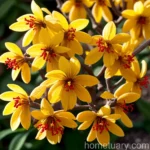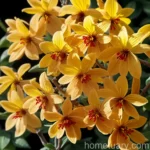Witch Hazel (Hamamelis x intermedia ‘Harry’)
Witch hazel (Hamamelis x intermedia ‘Harry’) is a captivating deciduous shrub that belongs to the Hamamelidaceae family. Its unique appearance, use in landscaping, and medicinal properties make it a sought-after addition to gardens and natural landscapes.
What is Witch Hazel (Hamamelis x intermedia ‘Harry’)?
Witch hazel ‘Harry’ is a hybrid shrub renowned for its vibrant and fragrant flowers that bloom in late winter to early spring. The plant’s botanical name, Hamamelis, is derived from the Greek words hama (together) and melon (apple), which refers to the simultaneous occurrence of fruit development and flowering.
Key Takeaways – Witch Hazel (Hamamelis x intermedia ‘Harry’)
The distinct features and benefits of witch hazel ‘Harry’ make it a valuable addition to any garden or landscape. Here are the key points to note about this remarkable plant:
- Cultural Significance: Witch hazel holds cultural and historical significance, often used in herbal remedies and skincare products.
- Fragrant Flowers: The plant blooms in late winter to early spring, adding vibrant colors and a delightful fragrance to the landscape.
- Medicinal Uses: Witch hazel extracts are renowned for their natural astringent and anti-inflammatory properties, making them popular in skincare and medicinal applications.
Now, let’s delve deeper into the cultural significance, uses, and essential care tips for witch hazel ‘Harry’.
Culture
Understanding the cultural requirements of witch hazel ‘Harry’ is pivotal to ensuring its healthy growth and thriving in the chosen environment. Here are the essential cultural aspects to consider:
Water
- Moisture Requirements: Witch hazel ‘Harry’ thrives in well-drained soil and prefers consistent moisture during its establishment phase. Adequate watering, especially during dry periods, is essential.
- Avoid Waterlogging: While it requires consistent moisture, the plant is susceptible to root rot if left in waterlogged conditions for prolonged periods.
Sunlight
- Light Conditions: Witch hazel ‘Harry’ performs best in partial shade to full sun, making it adaptable to a range of light conditions.
- Winter Sun: During winter, providing adequate sunlight is crucial for the plant’s overall health and successful flowering.
Fertilizer
- Nutrient Requirements: Applying a balanced fertilizer in early spring before new growth begins can promote the plant’s vigor and flowering.
- Natural Organic Fertilizers: The use of natural organic fertilizers is preferred for witch hazel ‘Harry’ to enhance soil health and microbial activity around the root zone.
Soil
- pH Preferences: Witch hazel ‘Harry’ thrives in slightly acidic to neutral soil conditions with a pH range of 5.5 to 6.5.
- Well-Drained Soil: Ensuring good soil drainage is essential to prevent waterlogged conditions and root diseases.
Pruning
Proper pruning of witch hazel ‘Harry’ is instrumental in enhancing its form, vigor, and flowering. Here are some key tips for effective pruning:
- Pruning Time: Prune witch hazel immediately after flowering to shape the plant and remove dead or damaged branches.
- Minimal Pruning: Minimal pruning is usually sufficient for maintaining the plant’s natural shape and allowing it to flourish.
Propagation
While witch hazel ‘Harry’ is predominantly propagated through grafting and cuttings, home gardeners can also explore propagation through seeds. Here are some insights into the propagation methods:
Grafting
- Grafting Technique: Propagating witch hazel ‘Harry’ through grafting involves joining a selected stem (scion) from the desired plant onto a compatible rootstock.
- Pruning and Grafting: The best time to propagate through grafting is during late winter or early spring, typically preceding the onset of new growth.
Cuttings
- Selecting Cuttings: Choose healthy, young stems for cuttings, typically from the previous year’s growth.
- Rooting Medium: Utilize a well-draining, sterile rooting medium and provide consistent moisture and warmth for successful root establishment.
Seed Propagation
- Seed Collection: Gather ripe witch hazel seeds in late summer to early fall and sow them in prepared seed beds during the autumn.
- Stratification: The use of cold stratification can enhance seed germination, mimicking natural conditions required by the seeds for successful sprouting.
Container Popularity
Witch hazel ‘Harry’ is well-suited for container gardening and can thrive in large pots or containers. Its adaptability to container growth enables gardening enthusiasts with limited space to enjoy the plant’s beauty and fragrance.
Container Care Tips
- Size Consideration: Use spacious containers that allow ample root growth and provide stability to the plant.
- Drainage: Ensure excellent drainage by adding a layer of gravel or using pots with pre-drilled drainage holes to avoid waterlogged conditions.
Common Diseases and Pests
Understanding the potential diseases and pests that affect witch hazel ‘Harry’ is crucial for early detection and effective management.
Disease Diagnosis
- Leaf Spot: Watch for signs of leaf spot, which may appear as circular lesions on the plant’s leaves. Provide proper ventilation and avoid overhead watering to prevent its occurrence.
- Powdery Mildew: Prevent powdery mildew by promoting good air circulation and ensuring adequate space between plants.
Common Pests
- Aphids: Keep an eye out for aphids infesting new growth, and employ natural predators or insecticidal soaps to manage their populations.
- Spider Mites: Monitor the undersides of leaves for spider mite activity and apply horticultural oils to control infestations.
Botanist’s Tips
As a botanist, I recommend the following tips for cultivating and appreciating the beauty of witch hazel ‘Harry’:
- Select a landscape spot that offers partial shade to protect the plant from harsh afternoon sunlight.
- Incorporate witch hazel ‘Harry’ in mixed borders or woodland gardens to create an eye-catching display and enjoy its captivating fragrance.
- Embrace the plant’s natural growth habit and minimal pruning requirements, allowing it to develop its signature architectural form.
Fun Facts
Discover some interesting and little-known facts about witch hazel ‘Harry’:
- The plant’s fragrant flowers have significant importance in aromatherapy, contributing a distinctive scent to various products.
- Witch hazel has a rich history in traditional medicine, often used to alleviate skin irritations, insect bites, and minor abrasions.
- Indigenous cultures in North America historically used witch hazel for its medicinal properties and spiritual significance.
Links to External Resources
Explore these external resources for further insights into witch hazel ‘Harry’ and its diverse applications:
- Royal Horticultural Society – Hamamelis x intermedia ‘Harry’: Gain detailed information about the plant’s characteristics, cultivation, and uses from the RHS.
- Missouri Botanical Garden – Witch Hazel: Delve into the botanical details and growth requirements of witch hazel for a comprehensive understanding.
- USDA Plant Guide – Witch Hazel: Access a comprehensive plant guide provided by the United States Department of Agriculture, offering in-depth insights into the species and its cultural practices.
In conclusion, witch hazel (Hamamelis x intermedia ‘Harry’) captures the imagination with its enchanting flowers, versatile uses, and enduring cultural significance. Whether incorporated into gardens or utilized for its medicinal properties, this exceptional shrub continues to enthrall plant enthusiasts and herbalists alike. Embracing the plant’s natural elegance and enriching its cultural legacy ensures that witch hazel ‘Harry’ remains a cherished presence in diverse landscapes, herbal traditions, and skincare routines.















